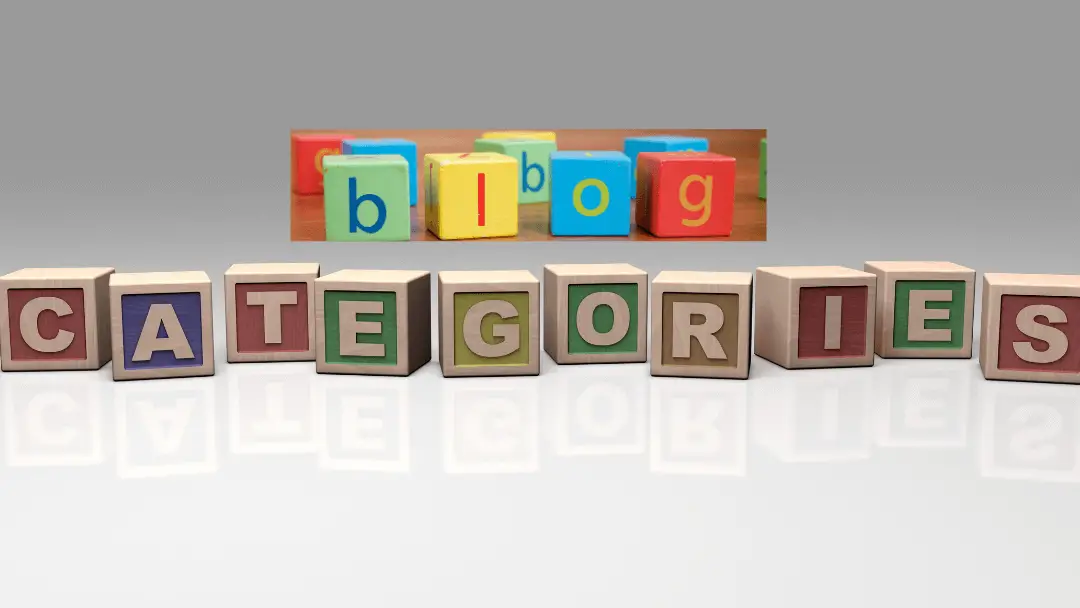Table of Contents
It is great to be able to blog with passion, but you also need to do so in a way that will keep your blog organised.
Blog categories help with this in two ways.
Firstly, blog categories help to keep your blog content well organised so that readers can find what they are looking for.
And secondly blog categories help you to keep yourself organised with a blog content plan. Having a blog content plan makes sure that you are regularly posting to all of your categories on a regular basis.
If you are wondering what is the best way to choose your blog categories to be better organised, then I’ ve got you covered.
In this post I am going to be covering
What is a Blog Category
How Many Blog Categories should you have
What about re-organising an older blog & categories
What if the blog category doesn’ t fit my content — what then?
How to decide on your Blog Category names
How to keep each category fresh
How to add your categories to your wordpress blog
Let’ s start at the beginning.
What is a Blog Category
A blog category is a way to keep your content on your blog organised. It shows clearly the topics that your blog covers.
Having blog categories helps readers to find content that they were searching for.
A blog category also helps your reader to understand what your blog is about.
The blog category is best explained as a table of contents in a book. It lays everything out in a simple format similar to that. This will allow readers to see at a quick glance the topics that are on your blog, which they want to learn more about.
*This post may contain affiliate links, which means I’ll receive a commission if you purchase through my links, at no extra cost to you. Please read full disclosure for more information*
How Many Blog Categories should you have
The first thing to decide on is how many blog categories to have.
Too many categories and you overwhelm your reader. They don’ t know where to look, what to read and end up leaving before they take a look at any of your content.
Too little categories and your authority may be brought into question. It may appear like you are not an authority or don’ t have enough content to keep them interested or solve their problem.
Which way should you go?
How do you decide how many categories is too many and what is too little?
I have personal experience with this. I had so so so many blog categories when I first started my blog. I really didn’ t know what I was doing. Palm sigh. But at least I got started and kept going with my blog.
Here’ s what I found worked best when deciding your blog categories
Keeping it simple is the best.
I would say that don’ t go over more than 5-8 categories.
Just think about it. If you go to a website and see 15 categories.
How overwhelming would that be?
Where do you look and where do you even start?
Also having so many categories can make it quite tricky when it comes to planning. It can become a muddle when trying to add content to each of your blog categories on a regular basis to manage so many categories.
When working out your categories you need to be clear on what your blog niche is.
Once you are clear on all of this, you will need to work out exactly what you want to tell your readers. More importantly, you need to tell them what they want to hear.
For example, if you are a mommy blogger, then your categories would reflect topics that mums want to read about.
The categories will, of course, depend on which sub-niche, within the mummy niche you are attracting. For example, if you are talking to new mums, then you will want to talk about what it may be like having a new baby and what to expect, based on your own personal experiences. You may have many ideas and things you wish you knew, which you wish to share in your mummy niche.
Below is an example of a Blog Category on a blog that would be for new mums.
They would want to know more about the pregnancy stages up until they return home with their newborn. It is a sub-niche within motherhood. Being clear on your categories at the start will keep your content clear and mums coming back to the blog, will know what to expect there.
Let me break this down a bit more, you could talk about any of the following topics in your blog posts: –
-Pregnancy and stages
-Planning for the birth
-The birth plan and the days after
-Taking your newborn home
-The first days at home with your new born
-Breastfeeding vs bottle
-What you need for the first days of feeding
-New parenthood tips
-How to get enough sleep
Now that is about 9 different ideas. But you do not want to have 9 different categories.
Look through the ideas in your content and see if they can fit under one specific category.
I can already see that some of the ideas will fit together under one blog category.
If I was starting out a blog like this, I would be able to condense this down to just 5 categories to get started.
If you’ve not started your blog then you want check out this guide How To Start Your Blog
The blog categories I would choose are:
Pregnancy and Stages
Planning for the Birth
Your Newborn Baby
Feeding Your Baby
New Parenthood Tips
Here’ s the content that would go into each of the categories:-
Pregnancy and stages — This is the exciting part and your content would talk about the stages of each pregnancy and what to expect. You can link to leading blog sites, that are health-related in order to back up information in these sections. For example “the first trimester ” the second trimester ” the third trimester, “signs to know and look out for in each trimester ” and “how to bloom in your pregnancy ”
Planning for the birth – You can have posts about “writing the birth plan ” “what to expect in the days after ” “C-Section versus natural birth ” “what items to buy ” “packing the hospital bag ”
Your New Born Baby — You can write posts about “taking your newborn home ”, “what equipment you will need for the journey home ”, “What equipment to have at home for the first days ” “the first days at home with your newborn ”
Feeding your baby – You can talk about “breastfeeding vs bottle ” “tips for breastfeeding ” “why you should not be upset if you cannot breastfeed ” “items you may find useful when feeding ” “reviews on different bottles and teats ”
New parenthood tips — Your content will need to help new parents. They will want to know “how to get enough sleep ” “ planning meals and freezer food tips ” “caring for themselves as well as baby ” “how to take a shower without a screaming baby ” (been there!!) “should you use a dummy or not ” “should you cuddle your baby each time they cry ”
Now that the categories are sorted.
You also know what sort of content you will be adding to each category. you can see how it all fits together and flows so the content is all related to the niche.
You can then work out your content plan and draft out blog posts.
Just having those categories will help you to brainstorm ideas. (those were the lists of topics that I thought of on the hop, without any research, so just imagine what you could come up with if you did your research)
What about re-organising an older blog & categories.
As I said this, was a problem I came across from personal experience. Having started my blog several years ago I made many mistakes and hadn’ t a clue what I was doing back then.
I had way too many categories. And they were all over the place.
I used to blog about anything and everything as it took my fancy.
Any guess what?
This got me zero views.
And worst of all, got me nowhere in my blogging journey, that is until I started to make these simple changes, that I am sharing today.
I streamlined my blog categories.
As I already had hundreds of blog posts, I tried to make these fit into the categories in my niche.
My niche is about helping mums to create an income from home using online methods such as blogging, product creation and affiliate marketing.
Here’ s what my blog categories look like now (I will probably tweak them a bit more as I continue, but they are fine for now).
I decided that the main categories were.
- Work at Home – how to create your digital lifestyle.
- Digital Mum Training to build an Online Lifestyle Business
These categories would point to training and tips and teach women how to learn the skills to build a digital lifestyle business whilst being at home with their family.
3. Blogging Tools Tips & Resources.
I decided that blogging was going to be one of the main topics I talked about. Here I talk about setting up your blog, writing your first blog post, and how to keep creating great content.
4 Pinterest — Tools Tips and resources
I decided that I was going to focus on one method for traffic generation and decided to use Pinterest. I wrote posts on how to set up your Pinterest account, how to increase Pinterest page views, what to do when your pinterest page views are decreasing.
5.Reviews — product reviews
In the reviews section, I write about products that I have used, give an opinion as to whether it was useful in my journey, and also promote products that I am an affiliate of.
6.Tutorial and Challenges —
This section where I offer the Free Video Workshop for mums who are thinking of starting out online. You will also find 7-day challenges to set up your website, 30-day tutorials to improve your SEO. I will keep adding to these with different challenges or tutorials.
7.Mindset – Living a Simpler Life
Whilst this last category may not seem relevant, believe me, it is. Having the right mindset is going to be key in moving forward in your journey. I also believe that the digital world can be overwhelming. I wanted to bring some balance to this aspect. In mindset, I will write about having balance in life and you can read what I thought about people who treat their mobile phones like their babies.
What if blog categories don’ t fit — what then?
I wasn’ t able to fit all of my previous blogs within the above categories.
For example one of my most popular posts was about a Henna night. Inspired after attending a henna night for the first time and feeling out of place due to not having the correct dress.
I wrote a post and it is still very popular on my blog. I’ ve left it up there as it has been helpful even though it is not really related to my niche. Maybe women will still find this post, take a look and find something else that will help them too, you never know.
How to decide on your Blog Category names
Remember that categories are there to help your reader to navigate your blog.
The key thing to do is to make your blog categories content-specific. Try keeping these clear and concise.
I would avoid trying to be too clever with unusual or catchy category names.
These often don’ t explain what the category is about.
When people first come to your blog, this may be the first time they have come there.
You will need to be able to show them simply what you write about.
Readers scan quickly. If they don’ t see what they are looking for or don’ t understand the blog category they are likely to click away and look elsewhere.
But wait…
there is also another school of thought.
Having catchy blog category names may create enough interest to tempt your reader to take a look.
Mommy on Purpose does this on her website
Under her category
Life With Kids
She has “tiny and squishy ” “sticky and wobbly” & “Fun With Kids ”.
You could guess that tiny and squishy would be to do with new born babies and the sticky and wobbly would be the toddler stage.
This can be a fun way to entice your reader.
Just make sure that your readers can understand what your categories are about and that the catchy names you have are not confusing.
Test these out with your readers or your nearest and dearest and see if they understand your blog category.
How to keep each category fresh
One of the challenges with blogging is of course fresh content that is both interesting and also solves a problem.
You also have to make sure that this fits in with your categories.
How do you do this and make sure that you’ re regularly posting to each category?
First you need to decide how often you will be posting content.
If this is once a week, twice a week or more often will depend on the time that you have set aside for blogging. Hopefully, you have worked out a time management plan.
I only update this blog once a week. I rotate the categories around them each week to make sure that the content is evenly distributed on the blog. I try to write on a different category each week, unless I’ m writing a series post which I need to continue over a few weeks. I’ ll be writing more on different post types later.
What I recommend is batch posting for each category.
What is batch posting, you may be asking?
This is when you have set time for your blog writing, you focus solely on writing several posts. Rather than write on a different category for each post, you may find it helpful to keep to a specific category and then write 5 blog posts for the category. This is batch posting for the category.
Batch posting is great, because if you are researching a topic then it makes sense to write as many posts as you can at the same time.
I would try to have at least 5 blog posts on each category as a minimum when you are getting started with your blog.
Also, in your draft content if you have followed my Blog Content Tips, then you will want to have at least this same number waiting to turn into quality content at short notice.
As much as you can plan ahead, we all know that life happens.
You know those days when baby hasn’ t slept, you are feeling a bit poorly and don’ t have the energy to lift the tea cup to your mouth let alone write a full blown blog post.
Just knowing that you have draft content ready to go will do a lot for your sanity. It will make sure that you don’ t fall behind with keeping your blog content fresh.
Now that you know how to choose your blog categories, you will want to know how to get these set up.
How to add your categories to your wordpress blog.
Go to your dashboard and hover over posts on the left hand side of your wordpress menu.
Select categories.
You should see a form like this.
Fill in the details to add a new category.
Remember the category tips above
-keep your category names in your niche
-keep your category names simple,
-keep your category names clear
Name — The name of the category you have chosen
Slug — url of the blog category as you want it to appear
Parent category — If you are wondering what the Parent category is, this will most likely be none unless you are adding lots of sub categories for your blog. (but this likely won’ t happen at the beginning of starting your blog – you can leave it blank for now)
Description — you can add a short description of the blog category.
Then click Add New Category
Continue adding your categories until you have added your 5-8 categories
Next go back into the left-hand side of WordPress dashboard menu.
Hover over “Appearance ” and select “menus ”
Next go to menu items and “select categories ” to display the categories you added earlier.
Check the box of categories you want to be displayed at the top of your blog.
When finished select “add to menu ”.
Double check that you have Primary Menu selected under menu settings on the same.
Lets recap:
In this post we talked about
What is a Blog Category
How Many Blog Categories should you have
What about re-organising an older blog & categories
What if the blog category doesn’ t fit my content — what then?
How to decide on your Blog Category names
How to keep each category fresh
How to add your categories to your wordpress blog
I hope that this has helped you in working out blog categories that will work well on your blog or at least has given you some ideas.
Let me know below what categories you have chosen for your blog and add a link so I can take look.











